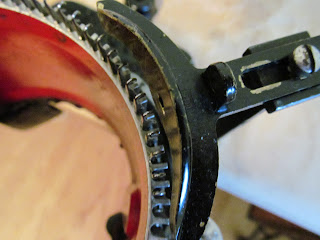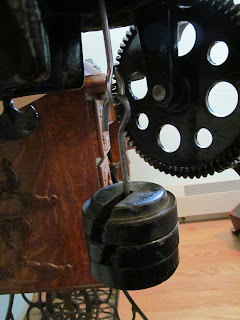Now that everything is cleaned and put back together, all that remains is to get this vintage sock knitting machine working.
I've been reading forms, watching videos (like these ones which are for the modern version of this machine), and asking the good people on Ravelry for advice. I've come to realize two important things: There are some really brilliant people on the internet, and the minuscule precision needed to make this machine work properly makes everything else I've repaired look like a block of wood. From sewing machines, power tools, spinning wheels, and all the other mechanical goodies I've worked on aren't anywhere close to what this machine is like to work with.
But lucky for me, the first thing I mentioned: those brilliant people who are willing to talk me through this.
This post is basically a bunch of pictures of things I've tried to make the machine work and a summation of many of the helpful tips I've been given. It doesn't have a happy ending ... yet. But I'm not giving up.
The V-cam:
I lowered the V-cam so that it is as low as it can go and not risk jamming.
I also switched the V-cam for the spare that came with the machine. The one that was in the machine showed signs of wear in one spot where it seems to be rubbing against the cylinder
The yarn guide:
And then I lowered again.
The yarn:
The yarn needs to feed freely from the source to the machine. So I took some off the spool and let it lay loose. Later on, once I've fixed the spool winder, I'll use some cheep sock yarn from my stash and see if this works better.
The weights:
Am I using the proper amount of weight for this task? I really don't know.
Apparently the weight is very important for the correct formation of stitches. Each of these disks weighs about a pound, so I thought I would try three pounds. Maybe next time I'll put the fourth on and see if that works better.
Casting On:
It's often been said that threading every second needle makes casting on easier. I think it makes it so the yarn does not get wound too tightly on the needles.
As you can see, there is still something wrong.
My next steps in the trouble shooting process
- try a different yarn
- get new needles - Angora Valley Fibres has them for sale.
- and as a final effort, find a mentor. A few people have been in touch, but all of them live out of town. But I suspect there are enough people in Victoria who are interested in learning about these machines. Some of them even have a machine or two in the basement waiting for guidance. Maybe some sort of clinic or workshop is in order?


















3 comments:
I didnt know there is this kind of machines in the world! In my eyes it looks like a mixture of typewriter and meat mill. Its very interesting!
Jani
Your idea of setting up a workshop sounds great! I'm sure you're right: quite a few people might be interested in getting together to learn about their sock machine.
Join Yahoo groups on sock knitting machines and ask if there is anyone close by, watch all the youtube videos on sock knitting machines you can. And WHEN ALL ELSE FAILS, USE PERSERVERENCE! I tought myself, it was a struggle until I got a video showing how to do it. A video and joining the groups will make it all clear.
Post a Comment